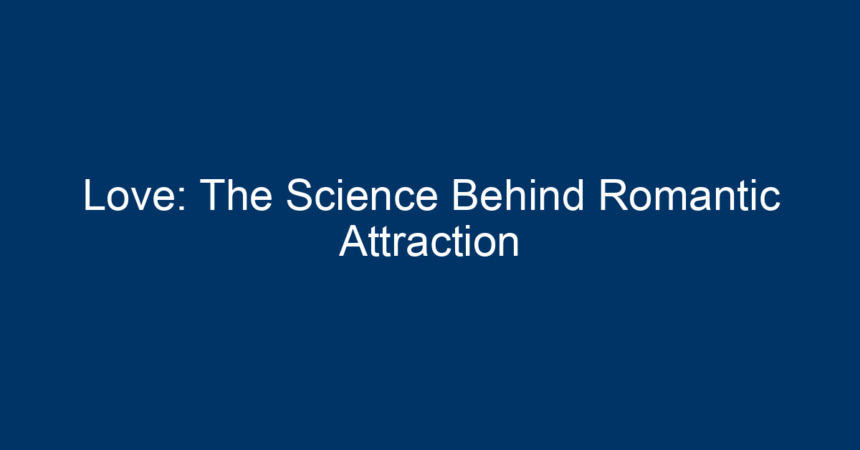Love is one of the most profound and powerful experiences in human life. It brings joy, fulfillment, and meaning, but what lies behind this exquisite emotion? Understanding romantic attraction is not just a matter of poetry or art; it’s also a subject of intense scientific inquiry. This article delves into the fascinating science behind romantic attraction, exploring biological, psychological, and social factors that influence our experiences of love.
The Biological Basis of Love
Hormones: The Love Chemicals
At the heart of romantic attraction lies a complex interplay of hormones. When we encounter someone we find appealing, our brains release a cocktail of neurotransmitters and hormones that enhance our feelings of affection. Here are the key players:
-
Dopamine: Often referred to as the "feel-good" hormone, dopamine creates feelings of pleasure and reward. When you’re in love, your brain has higher levels of dopamine, creating that euphoric "high" often associated with new relationships.
-
Oxytocin: Known as the "bonding hormone," oxytocin is released during physical touch and intimacy. This hormone plays a crucial role in deepening connections between partners, fostering feelings of trust and security.
- Serotonin: While love can boost serotonin levels, it can also lead to fluctuations that may cause obsessive thoughts about your partner—a common experience in the early stages of romance.
Brain Function: The Love Circuit
Imaging studies have revealed that romantic attraction activates specific areas in the brain, particularly those responsible for reward, motivation, and emotional regulation. When gazing at a loved one, areas like the ventral tegmental area (VTA) light up, signaling pleasure and reinforcing the desire to pursue the partner.
Psychological Factors Influencing Attraction
The Role of Attachment Styles
Our attachment styles, formed in childhood, play a significant role in how we experience romantic attraction. The main attachment styles include:
-
Secure: Individuals with secure attachment are comfortable with intimacy and trust their partners, leading to healthier relationships.
-
Anxious: These individuals may crave closeness but often fear rejection, creating a push-pull dynamic in relationships.
- Avoidant: Those with avoidant attachment tend to shy away from emotional closeness, often leading to conflict in romantic relationships.
Understanding your attachment style can provide insights into your romantic behaviors and help foster healthier connections.
The Importance of Similarity
Research shows that we are often attracted to those who share similar values, beliefs, and interests. This phenomenon, known as the "similarity-attraction hypothesis," suggests that shared experiences and viewpoints can deepen the emotional connection and enhance the likelihood of romantic attraction.
Social Factors Affecting Attraction
Cultural Influences
Culture shapes our notions of love and attraction. Different societies have diverse beliefs and expectations surrounding romantic relationships. For instance, in collectivist cultures, familial approval may be paramount, whereas, in individualist cultures, personal choice and romance often take center stage.
The Role of Proximity
The "mere exposure effect" posits that we tend to develop a preference for people simply because we see them more frequently. This is particularly relevant in educational or workplace settings, where regular interaction can lead to increased attraction over time.
The Evolutionary Perspective on Love
From an evolutionary standpoint, love serves a crucial purpose in human survival. Romantic attraction encourages pair bonding, which is essential for raising offspring. This bond not only facilitates child-rearing but also ensures genetic continuity. Key aspects include:
-
Mate Selection: We are naturally drawn to individuals who exhibit traits indicating good health, genetic fitness, and nurturing potential. These behaviors enhance reproductive success and contribute to the continuation of our species.
- Long-term Bonds: The emotional ties formed through love create a stable environment for offspring development, increasing their chances of survival.
The Phases of Love
Understanding the phases of love can offer deeper insights into our romantic relationships. Renowned psychologist Helen Fisher describes three primary phases:
1. Lust
This initial phase is primarily driven by sexual attraction and the desire for physical intimacy. Hormones like testosterone and estrogen are at play, igniting passion and desire.
2. Attraction
This phase is characterized by intense romantic feelings. As mentioned earlier, dopamine and norepinephrine flood the brain, leading to a euphoric sense of connection and excitement. However, it can also bring about obsessive thoughts and emotional highs and lows.
3. Attachment
In the final phase, deep emotional bonds develop. Oxytocin and vasopressin promote stability and a sense of security, making it easier to navigate life together as partners.
Navigating the Challenges of Romantic Attraction
While love can be exhilarating, it is not without challenges. Here are actionable insights to help you navigate romantic attraction more effectively:
Recognize Your Attachment Style
Understanding your own attachment style—and that of your partner—can facilitate healthier communication and emotional responses in your relationship. This awareness can minimize misunderstandings and foster deeper connections.
Create Shared Experiences
Invest time in creating shared experiences with your partner. Engage in activities that strengthen your bond, such as traveling together, taking classes, or exploring new hobbies. Shared experiences can enhance intimacy and deepen emotional connections.
Communicate Openly
Open and honest communication is vital. Discuss your feelings, desires, and concerns with your partner to cultivate trust and mutual understanding. This dialog can prevent resentment and promote emotional intimacy.
Embrace Vulnerability
It’s essential to be vulnerable in a romantic relationship. Allowing your partner to see your authentic self fosters closeness and enhances emotional bonding. While it might be intimidating, vulnerability often leads to deeper love and connection.
Seek Professional Help
If you’re struggling with love or facing challenges in your relationship, consider seeking guidance from a therapist or counselor. Professional insight can help you navigate barriers and strengthen your emotional connection.
Conclusion
The science of romantic attraction is a captivating blend of biology, psychology, and sociology. Understanding the intricacies of love can enable us to foster deeper connections and navigate relationships more effectively. Love is not just an emotion; it’s a beautifully complex tapestry woven from our biological instincts, psychological patterns, and social influences. By applying the insights shared in this article, you can enhance your approach to love and cultivate fulfilling, lasting romantic relationships. Embrace the science behind love and let it guide you to the connections you seek!




